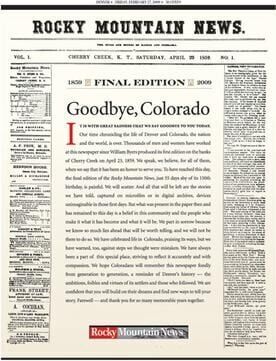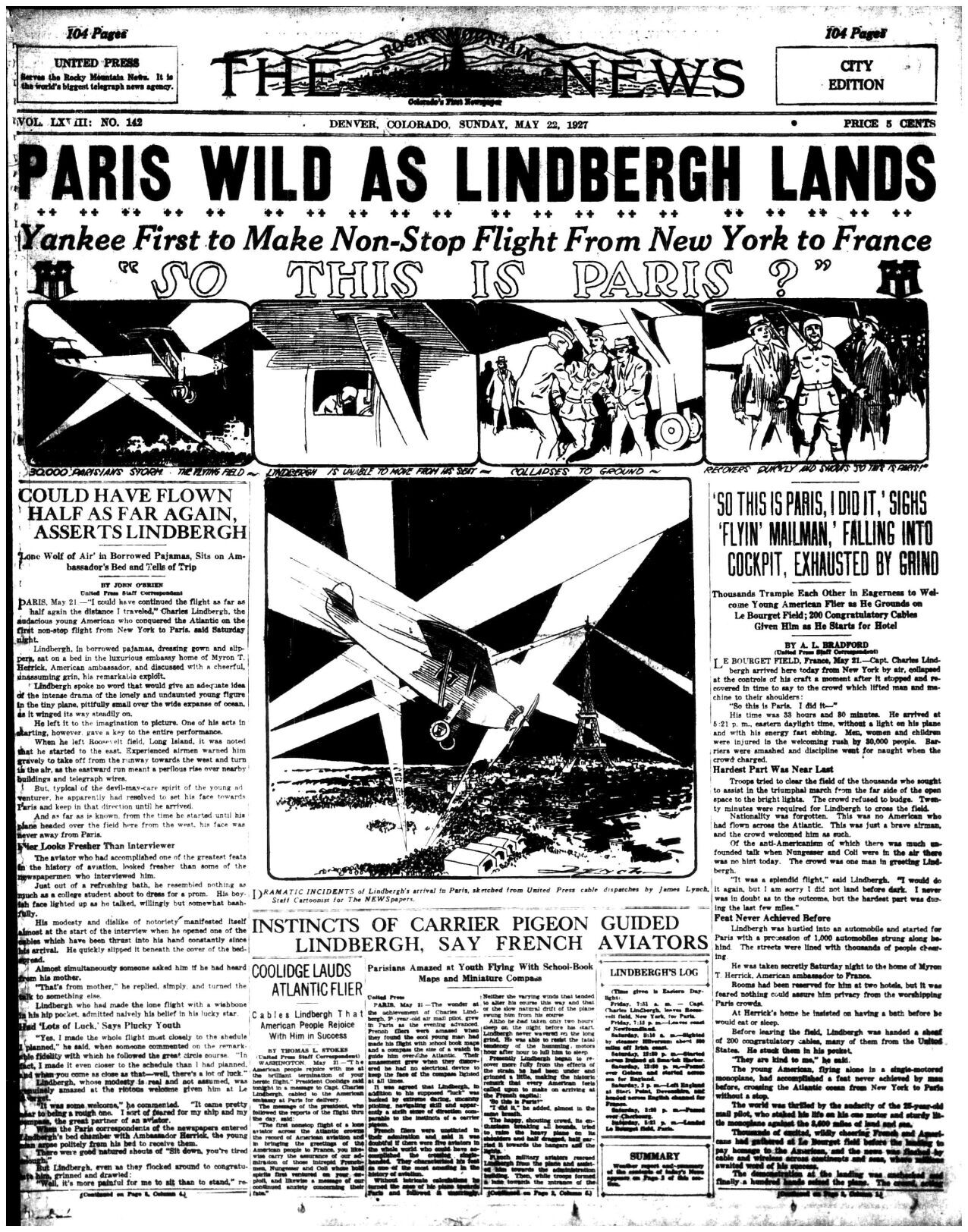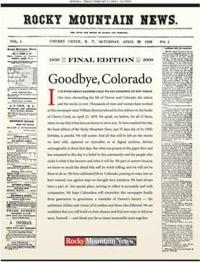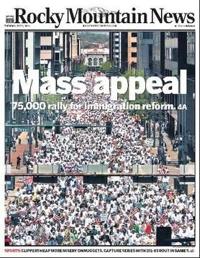Remembering the spirit of the Rocky 15 years gone | Vince Bzdek
When Jim Tankersly arrived at the Rocky Mountain News as a young reporter from the Portland Oregonian many years ago, he described the Rocky to editor Jim Trotter as such: “When the Oregonian sets out on a big story, it’s like a battleship steaming out to sea, gradually swinging its big gun turrets around. The Rocky is like a canoe with bazookas.”

The final edition of the Rocky Mountain News on Feb. 27, 2009.

The final edition of the Rocky Mountain News on Feb. 27, 2009.

The final edition of the Rocky Mountain News on Feb. 27, 2009.
It’s been 15 years this week since that well-armed canoe sailed on for good, but the memory of the scrappy, big-hearted paper lives on.
“It’s kind of amazing that it’s been 15 years,” John Temple, the last editor, publisher and president of the Rocky, told me. “I think Denver still misses the paper because we were clearly passionate about the city.”
The Rocky turned out to be the canary in the coal mine. It was one of the first major newspapers in the country to fold for financial reasons as the internet began to undermine the business model for news. A string of newspapers have since closed in its wake.

The final edition of the Rocky Mountain News on Feb. 27, 2009.
So why is there so much nostalgia — still — for the Rocky? Partly because it was thought of as The People’s Paper, a force for good that Denverites and Coloradans of every walk of life considered their own.
“The Rocky had that air,” Temple said, “it was going to be the guy at the cafe or the bar sitting next to you talking to you and not the guy in a suit lecturing you or telling you the way things were. It did have that earthy, everyman appeal.”
Temple remembers a readership survey that came back one time, and the survey people said: “’Your readership is like a Walmart store. You represent everybody.’ It had a really broad base of appeal.”
The tabloid format, with its blue-collar roots, reinforced that appeal. “I can’t tell you how powerful the format was. It was so easy to read that people really loved it. It was deeply ingrained, and it was unique to Denver.”
And the Rocky strove to be the hometown newspaper above all else.
“It was a real local paper,” Temple explains. Local news started right on page 2 (just as it does now in the Denver Gazette), not after the national and international news, and everything the Rocky did, the emphasis was local, local, local. “We felt like the most important thing we could do was provide local news, and that’s what we focused on.”

The Rocky Mountain News cover for a rally on immigration reform in 2006.
courtesy of Denver Public Library

The Rocky Mountain News cover for a rally on immigration reform in 2006.
Temple cites the Rocky’s response to 9/11 as an example of this local-above-all-else approach. It didn’t try to travel the world telling the story of 9/11 and its response. “What we could do well is explore and explain the impact of those events on Colorado and Coloradans,” he said. “And we ended up winning two Pulitzers for ‘Final Salute,’ which was reflective of our commitment to really showing how the war affected the homefront.”
“Final Salute” was a story by Jim Sheeler and a photo essay by Todd Heisler about a Marine major in Colorado who both notified and then helped the families of comrades killed in Iraq cope with their loss and honor their sacrifice.
Jim Trotter, who edited the “Final Salute” project and now oversees much of The Gazette’s enterprise reporting, seconds Temple’s sentiments about the paper’s special spirit. “It was definitely one of those newsrooms where everyone pulls for everyone else,” Trotter said. “You’ve been in newsrooms where there were rivalries and jealousies between reporters. It wasn’t like that. The nucleus of that staff was just a great team,” said Trotter.
“During that final period of the Rocky we had a really successful run,” Trotter remembers. “We had that stretch where we won four Pulitzers in seven years. Part of it came out of the competition with the Post. The fact that the competition was so fierce invested the individual reporters and editors and photographers in what they were doing.”
Temple likes to tell a story about columnist Gene Amole when describing why fondness for the Rocky persists 15 years later.
“Gene Amole was our leading columnist at the Rocky,” Temple reminds me. “Gene was a soldier in World War II, and many friends of his died. And he always told me that those people were frozen in time. They were forever young. They were never tarnished by the experiences, the suffering, the mistakes that happen as you go through life. They were remembered in this pristine, youthful way.”
The Rocky is similar, Temple believes.
“We remember it as a beautiful place in time. Closing it was very traumatic for everybody. But we weren’t destroyed by so many of the factors” that have affected papers since. So we remember it at a real high point. We fought to the end and then the rug was pulled.”
And Temple sees the Rocky’s spirit and legacy carried on by its survivors still.
“For the most part, people have gone on to do good things. We crashed, it was really difficult, but people were resilient. They became teachers, or they went into other news organizations, or they went out on their own in business. All kinds of people have gone on to make real contributions.”

The Rocky cover on the day after Charles Lindbergh’s famous flight to France in 1927.
Courtesy of the Denver Public Library

The Rocky cover on the day after Charles Lindbergh’s famous flight to France in 1927.
Jim Trotter, for example, who recently edited a series of stories on Colorado’s dysfunctional and dangerous family court system, stories that just won the prestigious national Polk Award for The Gazette. Or sports legend Woody Paige, who now writes for the Gazette and will soon be inducted into the Colorado Sports Hall of Fame. Or Rocky alum John Boogert, who is the award-winning editor of the Colorado Springs Gazette.
The Denver Gazette also runs a daily page from the Rocky archives to keep its memory alive. And the Denver Gazette has mimicked its tabloid format digitally, as well as its all-encompassing emphasis on local news to continue to give Denverites that hometown alternative.
It’s still all about the local, Temple reiterates.
The owner of the Rocky, Scripps Howard, was a conservative Midwestern company, much like the owner of The Denver Gazette, Philip Anschutz, who makes his home in Denver.
“Their belief was government closest to the people would make the best decision,” Temple remembers of Scripps. “And they believed decisions should be decided as close to the people as possible. They were really easy to work for that way because they had a really deep belief in the value of ‘local.’ It fit with their politically philosophy. ”
That philosophy is more important than ever with the loss of many local news outlets watchdogging local governments, Temple believes.
“One thing I loved about local news was, it’s actually what really matters to people. And really fundamental questions are being decided at the local level. It really connects you, because people know that person lived on that street, went to that school, and there’s something meaningful about that. Connection to a democracy and feeling like a citizen starts where you are.”
So here’s to the local, and to that intrepid canoe with the bazookas that I used to help steer to doorsteps in Congress Park 100 years ago as a young paperboy.
May the Rocky spirit live on forever.







